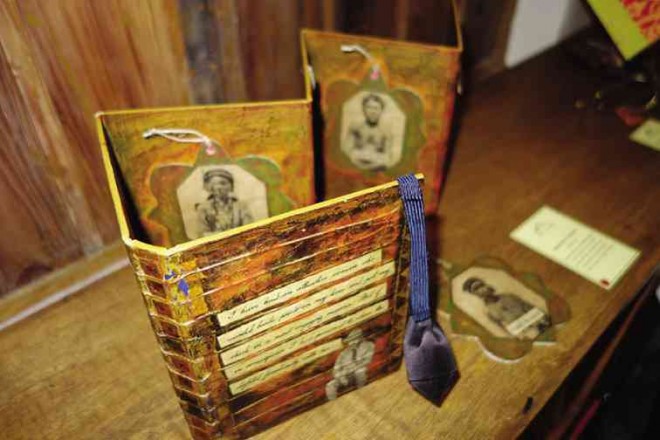
The quaint Mt. Cloud Bookshop, located in the basement of Casa Vallejo in Baguio City, has staged a remarkable show for book lovers and art aficionados: a book art exhibit by Cordillera studies scholar and all-around culture historian and critic Delfin Tolentino Jr. called “Bric-a-Brac.”
What is book art? It is a book conceptualized, designed and created by an author-artist. Aside from words, an assortment of tools and materials, usually paper products and images, is used to craft this unique object. The intertwining of its content and form seeks to offer a story, communicate an idea, or express the artist’s sensitivity to the world s/he lives in.
Its maker is a multi-artist and artisan: writer, painter, sculptor, photographer, graphic designer, needle-worker, drill operator, printer and binder all in one. In some cases, a book art may be more of a sculptural masterwork than a piece of writing.
Tolentino has 22 book art objects displayed in various niches inside Mt. Cloud. “The Blank Notebooks of Sei Shonagon, Awaiting Her Thoughts on ‘Things that Make One Nervous’” shows a small wooden case containing exquisite notebooks made of Japanese paper and stitched together using the four-hole binding technique.
The interior of the case is embellished with a postal stamp, a karuta game card, and a piece of daiki game tile. This objet d’art alludes to the historical court lady who wrote “The Pillow Book,” a collection of lists, stories, ruminations and poetry about life in the court during the middle Heian period.
Droll homage
“Thirty-Six Views of the Rice Terraces” rests on an armchair with side shelves. In concertina format, this object appears like an accordion of photographs, papers and bone pendants.
“Worcester’s Archive” is an altered book, which deploys a mixture of materials and techniques such as cutout images and pictures, parchment and handmade paper, acrylic paint and emulsion. The name refers to Dean Worcester, the American colonialist at the turn of the 20th century known for his photographs of ethnic people and places in the Philippines.
“Isang Matandang Lalaking May Napakalaking Pakpak” is Tolentino’s Filipino translation of Nobel laureate Gabriel Garcia Marquez’s short story “The Old Man with Enormous Wings.” The book’s pages, made of handcrafted paper and highlighted with vector art and graphics, are sewn together in the traditional Kangxi binding style.
In “Barthes/Baudrillard: Decontextualized Pronouncements,” the images and word cards on handmade paper are bound in Coptic style, i.e., laced together by chain-stitch sewing. This artwork seems a droll homage to French intellectuals and cultural critics Roland Barthes and Jean Baudrillard. On a flower-motif page, one particular statement will surely delight the selfie generation: “Hence, we take snapshots. Simulations are always better than the real.”
Tolentino is professor of Literature at the University of the Philippines in Baguio. He has served as dean of the College of Arts and Communication and director of Cordillera Studies Center. In 2008, he received the Gawad Pambansang Alagad ni Balagtas from the Unyon ng Manunulat sa Pilipinas (Umpil) for his scholarship on Filipino art and culture.
Since 1990s, his book art has been exhibited in Luz Gallery in Makati, Galeria de La Islas in Intramuros, Gallery Kamarikutan in Puerto Princesa, Sanctuary Gallery in Baguio, and Cultural Center of the Philippines Main Gallery, among others.
Later satisfaction
What then is the function of a book art?
German-Jewish stalwart of letters Walter Benjamin writes: “One of the foremost tasks of art has always been the creation of a demand which could be fully satisfied only later.”
“Bric-a-Brac” seems like a dogged recovery project, of stories, verses, letters, photos, prints, illustrations and other curios. It is a congregation of miniature and momentary significances which could be appreciated in bits and in passing by the Twitter generation.
As pastiche, it situates itself in the very fabric of tradition as it consciously deploys the many tools of the trade (e.g., photography, graphic design, pressing, printing, binding) and fiercely resists the inevitable departure of this medieval, pleasurable form. The escalating dominance of digital technology has rendered obsolete the book as a tactile object, a matter (that which occupies space and has weight). Everything else in the world today has opted to float somewhere in the cloud, or perhaps, shrink into a chip.
As a work of art in the age of digital reproduction, book art calls into question the conventions of what we know as book—a bound set of printed paper sheets meant to be flipped and read. It is art’s temperament to break whatever boundaries and limits that have been set by its predecessors. Ironically, the instruments that enable digital reproducibility also ensure that art thrives, even in multimedia or hypertext forms. However, each final object of art retains its unique existence in a historical time and space.
In his artist’s introduction to the exhibit, Tolentino avers: “In most cases, these handmade books are not meant to make big statements; there are only teasers here, or scattered utterances in a minor key.”
We the viewers agree: Teasers and simulations are better.

